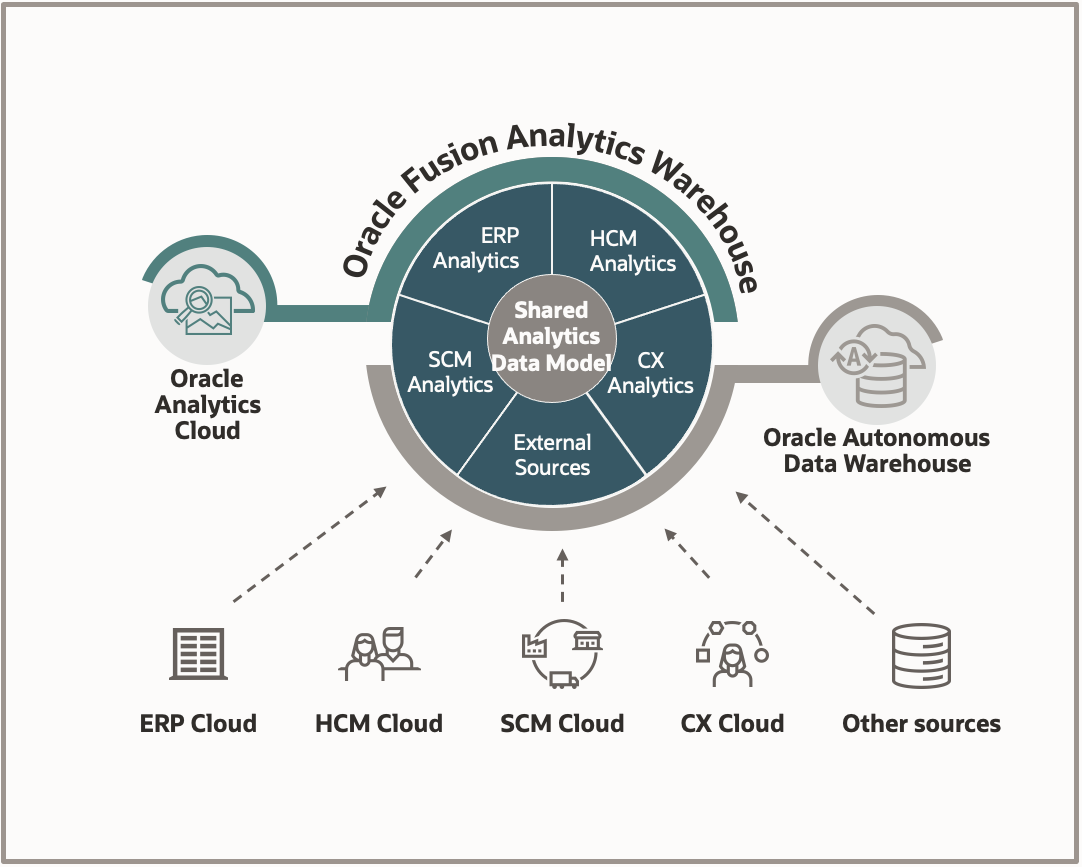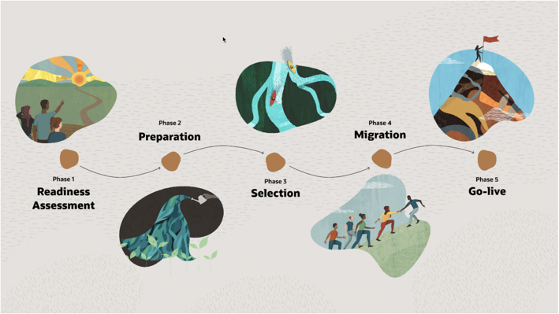
Published Version 11 on May 25th, 2024.
Oracle Fusion Analytics (Fusion Analytics) is a family of prebuilt, cloud-native analytics services designed to deliver personalized insights for Oracle Fusion Cloud Applications.

Included in Fusion Analytics are:
- A library of ready-to-use metrics and dashboards for faster collaboration.
- An extensible, Oracle-managed data platform with ready-to-use data extraction pipelines.
- An extensible, Oracle-managed semantic data model.
- An extensible, Oracle-managed security framework that leverages the security components in Oracle Fusion Cloud Applications.
This post is an Implementing Oracle Fusion Analytics Series member and guides the rollout/go-live readiness evaluation. It builds upon and assimilates the planning, preparing, provisioning, configuring, customizing, and migrating activities presented in preceding posts.
A Fusion Analytics implementation comprises a broad spectrum of activities. Save valuable time and prevent errors by carefully evaluating implementation readiness for the phase rolled out to the business community.

Go-live readiness, or rollout readiness, determines whether the business is fully prepared to accept and manage Fusion Analytics in production. Evaluate all prior implementation activities such as planning, preparing, provisioning, configuring, customizing, and migrating.

- The accelerated phased implementation approach is used as described in Leveraging the Fusion Analytics Accelerated Phased Approach.
- Planning was performed as described in the Planning a Fusion Analytics Implementation post.
- Configuration was performed as described in the Configuring and Validating a Fusion Analytics Implementation post.
- The required performance optimizations, customizations, and performance tests were performed as described in the Customizing a Fusion Analytics Implementation post.
- The Fusion Analytics content was migrated successfully from user acceptance to the production environment.

Project evaluation must be ongoing and revisited at different points throughout the implementation phase. The executive sponsor and project manager evaluate the project status and ensure that the Fusion Analytics phase is ready for rollout.
Recommendations- Gather reviews from all stakeholders for a successful project evaluation.
- Create a report with actual project timelines, costs, and resources for a proper evaluation.
- Ensure all tests are complete.
- Plan for change management and user training.
- Communicate the timelines to the stakeholders and business leaders.
- Develop a contingency plan in case of any delay.

The Fusion Analytics service administrator ensures that:
- A support process exists for users to report issues and that appropriate mitigation actions are taken.
- Fusion Analytics releases and patches are planned and communicated appropriately.
Setup a Support Process
- My Oracle Support is the initial point of contact for all product support needs.
- If you encounter issues with the product, file a Service Request (SR) so that Oracle Analytics support can assist in resolving the issue. The Oracle support contact details are available in the Fusion Analytics welcome email.
References
Manage Application Updates
Fusion Analytics provides quarterly application updates with the control and flexibility to choose when to apply the update. Oracle applies critical security patches automatically and has zero downtime. The auto-update process updates the data model, adds new content, and updates existing content. The process preserves activated functional area data pipelines and resets the other data pipelines to a Saved status.
Recommendations- View notifications displayed on the Fusion Analytics Release Updates page when application updates are available for major releases (quarterly basis), patches (monthly basis), and emergency fixes (as needed).
- Plan and communicate decisions on when these are applied.
- Ensure that release update activities align with the overall governance and compliance policies.
References

The Fusion Analytics service administrator and Fusion Cloud Applications security and setup administrators ensure the production Fusion Analytics environment is ready for rollout.
RecommendationsEnsure the following:
- The production Fusion Analytics environment is provisioned into the designated production OCI compartment.
- The designated production OCI compartment is secured appropriately through policy rules.
- The production Fusion Analytics environment is provisioned into the designated production OCI identity domain / IDCS stripe.
- If Fusion Analytics and Fusion Cloud Applications reside in separate cloud accounts/tenancies, ensure the designated production OCI identity domain / IDCS stripe is configured for:
- Synchronization of Fusion Cloud Applications users, job roles (groups), and group memberships.
- Single sign-on for Fusion Cloud Applications users.
- Production Fusion Analytics administrators are members of the appropriate administrative groups.
- The Fusion Cloud Applications production URL is accessible.
- The production Fusion Analytics environment is configured correctly to authenticate with the production Fusion Cloud Applications environment via a JWT (Java Web Token) or a password-based service user account.
- The production Autonomous Data Warehouse is accessible, and the sign-on credentials are correct.
- Network access to the production Fusion Analytics services is secured via access control lists, security lists, network security groups, network perimeters, etc.
- Is the Fusion Cloud Applications connection information correct?
- The Fusion Cloud Applications production URL?
- Does the authentication method test successfully, i.e., JWT token, Password-based?
- The production Fusion Analytics users and job roles/groups are synchronized with the Fusion Cloud Applications production environment.
- The production Fusion Analytics functional administrators and power users successfully use their Fusion Cloud Applications production credentials.
- The production Autonomous Data Warehouse is accessible, and the OAX_USER credentials are correct.

The Fusion Analytics service administrator and functional administrators ensure that an ATE (Additional Test Environment) is procured for user acceptance and performance testing before beginning the customization phase and that customizations meet all requirements and success criteria.
Top Five Customization RecommendationsEvaluate and ensure that:
- The phased approach was used for the prebuilt and customization phases.
- The scope of the customization phase was limited as much as possible to a subset of functional areas.
- Best practices and recommendations were followed when customizing workbooks, extending the semantic model, and augmenting data.
- The implementation team has training, experience, and certification in Fusion Analytics.
- Fusion Analytics customizations leveraged Fusion Cloud Applications custom data, security, and reporting.
Refer to Oracle Fusion Analytics Implementation Series: Customization for all customization recommendations and checklists.

The Fusion Analytics service administrator and functional administrators ensure that required performance optimizations and all performance tests are complete.
Top Five Required Performance OptimizationsEvaluate and ensure that:
- The documented guidance for workbook and visualization development was followed.
- ATE (Additional Test Environment)
- After activating the FDI subscriptions, subscribe to an ATE. Provision and scale it up when testing pipeline, single-user, and concurrent-user performance.
- Before going live, scale up the production environment to match the ATE.
- Ensure all visualizations respond within Oracle-recommended time frames and the time frames specified in the functional requirements.
- Ensure all security contexts are tested with a single user.
- Ensure a concurrency test is run with the number of concurrent users expected in the next 90 days.
- Ensure all pipelines finish within the time frame specified in the non-functional requirements.
- Ensure that customizations have not impacted the performance of pre-built content.
Refer to Oracle Fusion Analytics Implementation Series: Customization for all performance recommendations and checklists.

Note: Before importing the migration bundles, back up the production environment.
The Fusion Analytics service administrator ensures the migration of artifacts from the development and ATE is completed successfully.
Evaluate and ensure that:
- The phased approach is used for the migration.
- The source and production environment are on the same release and patch level.
- The production environment was successfully backed up.
- Bundles are successfully imported into Production.
- The data pipelines for the phase are activated in the production environment and completed successfully.
- Application roles are assigned to relevant user groups.
- Users are assigned to appropriate groups and security contexts.
- Subject area contents are visible to the appropriate users.
- Catalog folders and reporting objects are available to the appropriate users.
- Data is available to the appropriate users.
- Single-user author and consumer tests have confirmed Fusion Analytics data and objects are secured appropriately.
![]()
Complete the checklists as you prepare to roll out Fusion Analytics to users. The checklists provide an opportunity to document and ensure all required tasks are complete and best practices are utilized.
Project Checklist| Question | Response |
|---|---|
| Is the go-live date confirmed? | |
| Is the Production migration date confirmed? | |
| Are all tests complete?
|
|
| Have you scheduled enough time for the initial full data load? | |
| Is user readiness confirmed? | |
| Were best practices and recommendations followed? | |
| Are there any open severity-one issues? | |
| Is there a backup and recovery plan defined? | |
| Is there a group of users identified to communicate potential issues when Fusion Analytics is live? | |
| Is all the required information available to file support tickets with Oracle? | |
| Has the implementation team registered in the Oracle community? |
Support and Release Checklist
| Question | Response |
|---|---|
| Do you have a Customer Support Identifier(CSI) number? | |
| When signed into Oracle Support with the CSI number, is Fusion Analytics in the product list? | |
| Does the production release version match that of the development and ATE environments? | |
| Have you read and understood the Fusion Analytics release and update process? | |
| Have you established communication and scheduling plans for releases and updates? |
Migration Checklist
| Question | Response |
|---|---|
| Is the phased approach used for the migration? | |
| Are the source and production environments on the same release and patch level? | |
| Has the production environment been successfully backed up? | |
| Have the bundles been successfully imported into Production? | |
| Are the data pipelines for the phase activated in the production environment, and have they been completed successfully? | |
| Are application roles assigned to relevant user groups? | |
| Are users assigned to appropriate groups and security contexts? | |
| Are subject area contents visible to appropriate users? | |
| Are catalog folders and reporting objects available to appropriate users? | |
| Is data available to appropriate users? | |
| Have single-user author and consumer tests confirmed Fusion Analytics data and objects are secured appropriately? |
![]()
Return to the Fusion Analytics Implementation Overview for the next steps in the implementation journey.
Explore Fusion Analytics by visiting the community links, blogs, and library.
Implementing Oracle Fusion Analytics Series
Fusion Analytics Implementation Guide
![]() var coll = document.getElementsByClassName(“collapsible”);
var i;
for (i = 0; i < coll.length; i++) {
coll[i].addEventListener("click", function() {
this.classList.toggle("active");
var content = this.nextElementSibling;
if (content.style.display === "block") {
content.style.display = "none";
} else {
content.style.display = "block";
}
});
}
var coll = document.getElementsByClassName(“collapsible”);
var i;
for (i = 0; i < coll.length; i++) {
coll[i].addEventListener("click", function() {
this.classList.toggle("active");
var content = this.nextElementSibling;
if (content.style.display === "block") {
content.style.display = "none";
} else {
content.style.display = "block";
}
});
}

